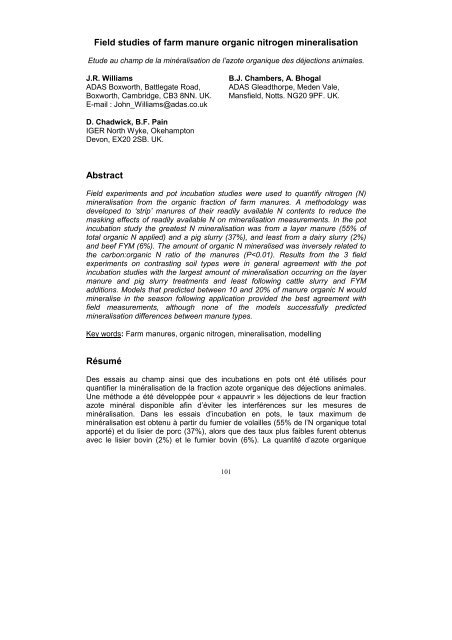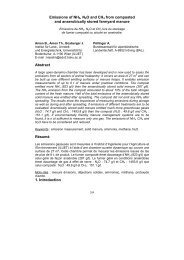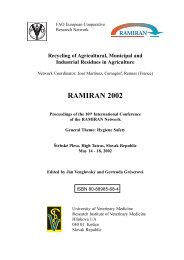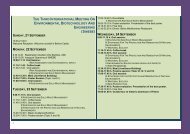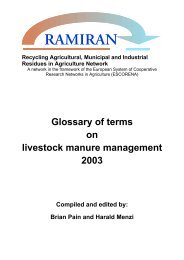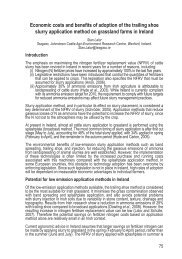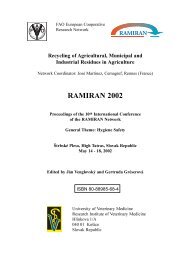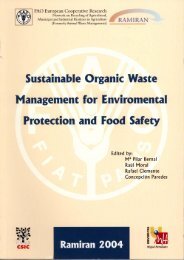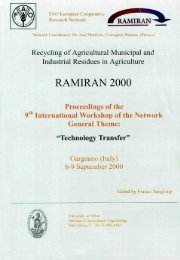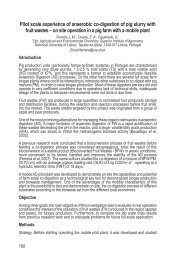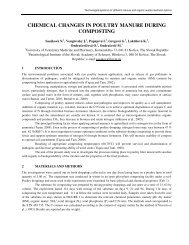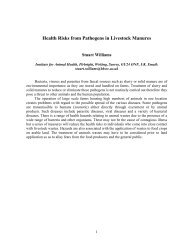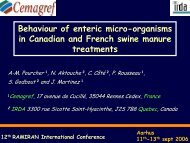Field studies of farm manure organic nitrogen mineralisation - Ramiran
Field studies of farm manure organic nitrogen mineralisation - Ramiran
Field studies of farm manure organic nitrogen mineralisation - Ramiran
You also want an ePaper? Increase the reach of your titles
YUMPU automatically turns print PDFs into web optimized ePapers that Google loves.
<strong>Field</strong> <strong>studies</strong> <strong>of</strong> <strong>farm</strong> <strong>manure</strong> <strong>organic</strong> <strong>nitrogen</strong> <strong>mineralisation</strong><br />
Etude au champ de la minéralisation de l’azote organique des déjections animales.<br />
J.R. Williams<br />
ADAS Boxworth, Battlegate Road,<br />
Boxworth, Cambridge, CB3 8NN. UK.<br />
E-mail : John_Williams@adas.co.uk<br />
B.J. Chambers, A. Bhogal<br />
ADAS Gleadthorpe, Meden Vale,<br />
Mansfield, Notts. NG20 9PF. UK.<br />
D. Chadwick, B.F. Pain<br />
IGER North Wyke, Okehampton<br />
Devon, EX20 2SB. UK.<br />
Abstract<br />
<strong>Field</strong> experiments and pot incubation <strong>studies</strong> were used to quantify <strong>nitrogen</strong> (N)<br />
<strong>mineralisation</strong> from the <strong>organic</strong> fraction <strong>of</strong> <strong>farm</strong> <strong>manure</strong>s. A methodology was<br />
developed to ‘strip’ <strong>manure</strong>s <strong>of</strong> their readily available N contents to reduce the<br />
masking effects <strong>of</strong> readily available N on <strong>mineralisation</strong> measurements. In the pot<br />
incubation study the greatest N <strong>mineralisation</strong> was from a layer <strong>manure</strong> (55% <strong>of</strong><br />
total <strong>organic</strong> N applied) and a pig slurry (37%), and least from a dairy slurry (2%)<br />
and beef FYM (6%). The amount <strong>of</strong> <strong>organic</strong> N mineralised was inversely related to<br />
the carbon:<strong>organic</strong> N ratio <strong>of</strong> the <strong>manure</strong>s (P
minéralisé est inversement corrélée au ratio carbone sur azote organique des<br />
déjections (P < 0.01).<br />
Les résultats issus de 3 essais au champ sur des sols différents confirment les<br />
observations en laboratoire. Les modèles qui prédisent qu’un taux de minéralisation<br />
compris entre 10 et 20% sera obtenu au cours de la saison suivant l’épandage<br />
corroborent les résultats obtenus au champ, mais ne permettent toutefois pas<br />
d’expliquer les différences entre les différents types de déjections.<br />
Mots-clés : Déjections animales, azote organique, minéralisation, modélisation.<br />
1. Introduction<br />
In the UK, applications <strong>of</strong> animal <strong>manure</strong> to agricultural land supply ca. 450,000<br />
tonnes <strong>of</strong> <strong>nitrogen</strong> per annum, <strong>of</strong> which ca. 300,000 tonnes are estimated to be<br />
present as <strong>organic</strong> N and ca. 150,000 tonnes in readily plant available N forms<br />
(principally ammonium and uric acid-N). Typically, 75-90% <strong>of</strong> the total N content <strong>of</strong><br />
straw-based <strong>farm</strong>yard <strong>manure</strong>s (FYM) is present as <strong>organic</strong> N, 50-60% for poultry<br />
<strong>manure</strong>s and 40-50% for slurries (MAFF, 1994).<br />
Research in the UK has largely focused on readily available N forms as these have<br />
the greatest influence in the short-term on crop fertiliser N supply, ammonia<br />
volatilisation and nitrate leaching losses (Jarvis and Pain, 1990; Unwin et al., 1991;<br />
Chambers et al., 1997). In the longer-term, <strong>organic</strong> N <strong>mineralisation</strong> will have<br />
increasingly important effects on N supply, particularly in situations where repeated<br />
<strong>manure</strong> applications are made to land. If <strong>mineralisation</strong> <strong>of</strong> the applied <strong>organic</strong> N<br />
occurs during periods <strong>of</strong> crop growth (spring-summer) fertiliser N requirements will<br />
be reduced, but if <strong>mineralisation</strong> occurs during the autumn-winter period, nitrate<br />
leaching and denitrification losses are likely to increase.<br />
This paper describes results from pot incubation and field <strong>studies</strong> to quantify N<br />
<strong>mineralisation</strong> from the <strong>organic</strong> fraction <strong>of</strong> <strong>farm</strong> <strong>manure</strong>s. Mineralisation<br />
measurements at the field sites were compared with values predicted by selected<br />
<strong>manure</strong> N models.<br />
2. Methodology<br />
Quantifying <strong>organic</strong> N <strong>mineralisation</strong> is complicated by the presence <strong>of</strong> <strong>of</strong>ten large<br />
quantities <strong>of</strong> readily available N (principally ammonium-N and for poultry <strong>manure</strong>s,<br />
uric acid -N). Methodologies involving sedimentation (for slurries) and controlled<br />
drying were developed to “strip” the <strong>manure</strong>s <strong>of</strong> their readily available N contents.<br />
The techniques were effective for the pot incubation <strong>studies</strong> (17 <strong>manure</strong> samples)<br />
and field experiments (9 <strong>manure</strong> samples) at reducing the readily available N<br />
content <strong>of</strong> the cattle <strong>manure</strong> samples to < 1% and < 5% <strong>of</strong> total N, for the pig<br />
<strong>manure</strong> samples < 2% and < 10%, and for the poultry <strong>manure</strong> samples < 3% and <<br />
10%, respectively.<br />
102
2.1. Pot incubation <strong>studies</strong>.<br />
N <strong>mineralisation</strong> from the <strong>organic</strong> N fraction <strong>of</strong> 17 <strong>manure</strong>s (3 cattle slurry, 3 cattle<br />
FYM, 3 pig slurry, 4 pig FYM and 4 poultry <strong>manure</strong>s) was measured under uniform<br />
conditions <strong>of</strong> light (16 hour photo period), temperature (18°C days and 12°C<br />
nights) and soil moisture status (60% <strong>of</strong> moisture holding capacity) for a period <strong>of</strong> 6<br />
months. The ammonium -N “stripped” <strong>manure</strong>s were mixed with a loamy sand<br />
textured soil in pots 16.5 cm x 16.5 cm x 20 cm), and sown with perennial ryegrass<br />
(Lolium perenne L.). The treatments were arranged in a randomised block design<br />
with three replicates <strong>of</strong> each treatment.<br />
The <strong>manure</strong>s were analysed for dry matter, <strong>organic</strong> carbon (C), total N, ammonium-<br />
N and for poultry <strong>manure</strong>s, uric acid-N. Target applications were 200 kg/ha total N<br />
with additional phosphorus, potassium and sulphur applied in solution to the pots to<br />
ensure that grass growth was not limited by an inadequate supply <strong>of</strong> major nutrients<br />
other than <strong>nitrogen</strong>. Six grass cuts were taken during the experiment, with the<br />
ryegrass N <strong>of</strong>ftakes used as a measure <strong>of</strong> <strong>organic</strong> N <strong>mineralisation</strong>.<br />
2.2. <strong>Field</strong> <strong>studies</strong><br />
In June 1996, field experiments were established at 3 sites with contrasting soil<br />
types and climatic conditions (Table 1), to measure N <strong>mineralisation</strong> from the<br />
<strong>organic</strong> N fraction <strong>of</strong> 9 <strong>farm</strong> <strong>manure</strong>s (2 cattle slurry cattle FYM and pig FYM, 1 pig<br />
slurry, layer <strong>manure</strong> and broiler litter) and six in<strong>organic</strong> N treatments (0-150 kg/ha).<br />
There were 3 replicates <strong>of</strong> each treatment in a randomised block design.<br />
At each site, ammonium-N “stripped” <strong>manure</strong>s were applied to the plots (3 m x 10<br />
m) prior to the establishment <strong>of</strong> perennial rye grass. The <strong>manure</strong>s were left on the<br />
soil surface for 48 hours after application to encourage further ammonia<br />
volatilisation before incorporation. 1 m 2 mesh squares were placed randomly on<br />
each plot before application so that samples <strong>of</strong> the <strong>manure</strong>s could be collected at<br />
the time <strong>of</strong> soil incorporation. The <strong>manure</strong> samples were analysed for dry matter,<br />
total C, total N, ammonium-N and for poultry <strong>manure</strong>s uric acid-N, so that the<br />
amount <strong>of</strong> N applied to each treatment could be quantified (Table 2). At ADAS<br />
Rosemaund, extremely dry weather after the experiment was set up meant that the<br />
grass did not germinate. Grass was satisfactorily established on the plots in<br />
February 1997.<br />
Site Soil texture Average annual<br />
rainfall (mm)<br />
Topsoil total N<br />
(%)<br />
Topsoil <strong>organic</strong><br />
matter (%)<br />
ADAS Gleadthorpe Loamy sand 650 0.04 1.7<br />
ADAS Rosemaund Silty clay loam 800 0.20 2.9<br />
IGER North Wyke Sandy loam 1000 0.08 1.8<br />
103
Table 1.<br />
Soil type, cropping and average annual rainfall<br />
Between June 1996 and June 1997, 5 grass cuts were taken at Gleadthorpe and 4<br />
at North Wyke. The late grass establishment at Rosemaund meant that only 1 cut<br />
was possible.<br />
Total N loading (kg/ha)<br />
Treatment Gleadthorpe North Wyke Rosemaund<br />
Cattle FYM 1 526 632 1366<br />
Cattle FYM 2 901 848 824<br />
Pig FYM 1 863 1031 816<br />
Pig FYM 2 794 861 1024<br />
Cattle slurry 1 172 364 231<br />
Cattle slurry 2 676 724 569<br />
Pig slurry 577 543 639<br />
Layer <strong>manure</strong> 674 364 326<br />
Broiler litter 659 638 444<br />
Table 2.<br />
N loadings at each field site following application <strong>of</strong> ammonium-N stripped <strong>manure</strong>s<br />
Porous ceramic cups (Webster et al., 1993) were installed at 90 cm depth on each<br />
<strong>manure</strong> treatment (4 per plot) to measure nitrate leaching losses. Drainage<br />
estimates were made using the IRRIGUIDE meteorological model (Bailey and<br />
Spackmann, 1996) with leachate samples collected every 2 weeks or following 25<br />
mm <strong>of</strong> drainage whichever occurred sooner, for nitrate-N analysis. Nitrate-N<br />
concentrations in porous cup samples were combined with drainage volume<br />
estimates between the sampling dates to measure nitrate-N leaching losses (Lord<br />
and Shepherd, 1993). Soil temperatures were measured daily and soil moisture<br />
contents monthly.<br />
The sum <strong>of</strong> plant N uptakes and nitrate leaching measurements on the control was<br />
subtracted from those on the <strong>manure</strong> treated plots to quantify <strong>organic</strong> N<br />
<strong>mineralisation</strong>. The <strong>mineralisation</strong> measurements were corrected for the small<br />
amount <strong>of</strong> readily available N applied in the <strong>manure</strong>s.<br />
Dry matter yields on the <strong>manure</strong> treatments in year 1 were compared with the yields<br />
on the in<strong>organic</strong> N treatments to calculate the fertiliser equivalent value <strong>of</strong> the<br />
mineralised <strong>organic</strong> N.<br />
2.3. Modelling<br />
<strong>Field</strong> assessments <strong>of</strong> <strong>manure</strong> <strong>organic</strong> N <strong>mineralisation</strong> at Gleadthorpe and North<br />
Wyke were compared with predictions from N-CYCLE (Scholefield et al., 1991),<br />
MANNER (Chambers et al., 1998) and other <strong>manure</strong> models; Beauchamp and Paul<br />
(1989), Bhat et al., (1989) and Diltz et al., (1990).<br />
104
3. Results and discussion<br />
3.1. Pot Incubation <strong>studies</strong><br />
Net N <strong>of</strong>ftakes were greatest from a layer <strong>manure</strong> (115 kg/ha N) and a pig slurry<br />
(60 kg/ha N) and least from a dairy slurry (3 kg/ha N) and a beef FYM (13 kg/ha ).<br />
During the 60 days following incorporation <strong>of</strong> the <strong>manure</strong>s, net immobilisation was<br />
measured on the dairy slurry and beef FYM treatments. By the fourth harvest (120<br />
days), the <strong>mineralisation</strong> rates had decreased to low, relatively constant levels for<br />
all <strong>manure</strong> types.<br />
70<br />
Figure 1. N mineralised from different <strong>manure</strong> types<br />
60<br />
50<br />
% <strong>organic</strong> N applied<br />
40<br />
30<br />
Dairy<br />
Beef<br />
Pig<br />
Poultry<br />
20<br />
10<br />
0<br />
S S FYM S FYM FYM S S S FYM FYM FYM FYM BLIT BLIT BLIT LAYF<br />
Notes S = slurry, FYM = <strong>farm</strong>yard <strong>manure</strong>, BLIT = broiler litter, LAY = layer <strong>manure</strong><br />
Figure 1<br />
Mineralised from different <strong>manure</strong> types.<br />
105
C : <strong>organic</strong> N ratio<br />
16<br />
14<br />
12<br />
y = -0.14x + 14.04<br />
r2 = 40%<br />
P
Cumulative day degrees above 5°C<br />
1750<br />
1550<br />
1350<br />
1150<br />
950<br />
750<br />
550<br />
350<br />
150<br />
Aug<br />
1996<br />
Sept Oct Nov Dec Jan<br />
1997<br />
Month<br />
Feb Mar Apr May Jun<br />
ADAS Gleadthorpe<br />
ADAS Rosemaund<br />
IGER North Wyke<br />
Figure 3<br />
Cumulative day degrees above 5°C at 10 cm soil depth.<br />
At Rosemaund, N uptakes were lower than the other sites because <strong>of</strong> the late<br />
grass establishment. The greatest uptake was 140 kg/ha N measured on the pig<br />
slurry treatment and least 27 kg/ha on the cattle slurry - 2 treatment.<br />
At all three sites net N <strong>mineralisation</strong> was continuing 18 months after the <strong>manure</strong>s<br />
had been applied.<br />
Nitrate leaching<br />
At Gleadthorpe and North Wyke, nitrate leaching losses from the cattle FYM, cattle<br />
slurry and pig FYM-2 treatments were similar at ca. 5 kg/ha N. Losses on the pig<br />
FYM-1, pig slurry and poultry <strong>manure</strong> treatments were ca. 10, 15 and 20 kg/ha N at<br />
Gleadthorpe, and 25, 50 and 10 kg/ha N at North Wyke, respectively. The failure to<br />
establish a grass cover at Rosemaund meant that there was no plant N uptake<br />
before drainage began over winter 1996/97 and as a consequence nitrate leaching<br />
losses were overall greater than at the other sites in the range 25-50 kg/ha N.<br />
Mineralisation<br />
Generally, <strong>organic</strong> N <strong>mineralisation</strong> (sum <strong>of</strong> net plant uptake and net N leached)<br />
was greatest following the pig slurry and layer <strong>manure</strong> applications, with 52% and<br />
36% <strong>of</strong> the applied <strong>organic</strong> N mineralised at Gleadthorpe, and 67% and 60% at<br />
North Wyke, respectively. At Rosemaund the greatest amount <strong>of</strong> <strong>mineralisation</strong><br />
occurred on the cattle slurry-2 treatment (31%) followed by the pig slurry treatment<br />
(25%), Figure 4.<br />
107
% <strong>organic</strong> N applied<br />
80<br />
70<br />
60<br />
50<br />
40<br />
ADAS Gleadthorpe<br />
ADAS Rosemaund<br />
IGER North Wyke<br />
30<br />
20<br />
10<br />
0<br />
Cattle<br />
FYM 1<br />
Cattle<br />
FYM 2<br />
Pig<br />
FYM 1<br />
Pig<br />
FYM 2<br />
Cattle Cattle<br />
slurry 1 slurry 2<br />
Pig<br />
slurry<br />
Broiler<br />
litter<br />
Layer<br />
<strong>manure</strong><br />
Figure 4<br />
Net <strong>mineralisation</strong> between June 1996 to June 1997.<br />
The field <strong>mineralisation</strong> measurements were in general agreement with those<br />
obtained in the pot incubation study, although it was not possible to establish a<br />
relationship between the field N <strong>mineralisation</strong> measurements and C : <strong>organic</strong> N<br />
ratio <strong>of</strong> the applied <strong>manure</strong>s.<br />
In the first growing season following application (i.e. six months from June to<br />
December), grass dry matter yields on the cattle FYM - 1, cattle FYM -2 and cattle<br />
slurry - 2 treatments were equivalent to those from in<strong>organic</strong> fertiliser N applications<br />
<strong>of</strong> 96, 101 and 117 kg/ha N at Gleadthorpe and 88, 102 and 84 kg/ha N at North<br />
Wyke, respectively. Dry matter yields on the pig FYM-2 treatment at Gleadthorpe,<br />
the pig FYM -1 and broiler litter treatments at North Wyke were equivalent to 121,<br />
129 and 89 kg/ha fertiliser N applications, respectively. It was not possible to<br />
calculate fertiliser N equivalents for the other treatments because dry matter yields<br />
exceed those <strong>of</strong> the 150 kg/ha fertiliser N applications. At Rosemaund failure to<br />
establish a grass crop meant that it was not possible to determine fertiliser N<br />
equivalents in the first season following <strong>manure</strong> application.<br />
Modelling<br />
The field measurements <strong>of</strong> N <strong>mineralisation</strong> at Gleadthorpe and IGER (June 1996<br />
to June 1997) were compared with model predictions. Comparisons <strong>of</strong> the field<br />
measurements and model predictions for cattle FYM-1, layer <strong>manure</strong> and pig slurry<br />
treatments are shown in Figure 5 and Figure 6.<br />
108
N mineralised (kg/ha)<br />
500<br />
400<br />
300<br />
200<br />
<strong>Field</strong> measurement<br />
N CYCLE<br />
MANNER<br />
Beauchamp and Paul<br />
Bhat<br />
Dilz<br />
100<br />
0<br />
Cattle FYM Layer <strong>manure</strong> Pig slurry<br />
Figure 5<br />
Predicted and measured N <strong>mineralisation</strong>, ADAS Gleadthorpe<br />
N mineralised (kg/ha)<br />
600<br />
500<br />
400<br />
300<br />
200<br />
<strong>Field</strong> measurement<br />
N CYCLE<br />
MANNER<br />
Beauchamp and Paul<br />
Bhat<br />
Dilz<br />
100<br />
0<br />
Cattle FYM Layer <strong>manure</strong> Pig slurry<br />
Figure 6<br />
Predicted and measured N <strong>mineralisation</strong>, IGER North Wyke.<br />
109
In general, the best quantitative predictions were provided by N-CYCLE, MANNER<br />
and the Beauchamp and Paul (1989) model. This was because these models<br />
estimated that between 10 and 20% <strong>of</strong> the <strong>organic</strong> N was mineralised in a first<br />
growing season after application. The Bhat et al. (1989) and Dilz et al. (1990)<br />
models over estimated <strong>mineralisation</strong> under these conditions, because they<br />
assumed that 80% and 46% respectively <strong>of</strong> the <strong>organic</strong> N would mineralise. None<br />
<strong>of</strong> the models were able to predict <strong>mineralisation</strong> differences between the <strong>manure</strong><br />
types.<br />
5. Acknowledgement<br />
Funding <strong>of</strong> this work by the UK Ministry <strong>of</strong> Agriculture Fisheries and Food (MAFF) is<br />
gratefully acknowledged.<br />
6. References<br />
Bailey R.J. and Spackmann, (1996). A model for estimating soil moisture changes<br />
as an aid to irrigation scheduling and crop water-use <strong>studies</strong>: I Operational details<br />
and description. Soil Use and Management 12 122-129.<br />
Beauchamp, E.G. and Paul, J.W., (1989). A simple model to predict <strong>manure</strong> N<br />
availability to crops in the field. In: Nitrogen in Organic Wastes Applied to Soils<br />
(Eds: J.A. Hansen and H.Henriksen) pp 140-149. Academic Press London.<br />
Bhat, K.H.S., Flowers, T.H. and O’Callaghan, J.R. (1989). A model for simulation<br />
<strong>of</strong> the fate <strong>of</strong> <strong>nitrogen</strong> in <strong>farm</strong> wastes on land application. In Nitrogen Losses and<br />
Surface Run<strong>of</strong>f (Ed:J.C. Brogan) pp 222 -250 Brussels.<br />
Chambers, B.J., Smith, K.A. and van der Weerden, T.J., (1997). Ammonia<br />
emissions following the land spreading <strong>of</strong> solid <strong>manure</strong>s. In : Gaseous Nitrogen<br />
Emissions from Grassland (Eds: S.C. Jarvis and B.F. Pain), pp 275-280. CAB<br />
International UK.<br />
Chambers, B.J., Lord, E.I., Nicholson, F.A. and Smith, K.A., (1998). Predicting<br />
<strong>nitrogen</strong> availability and losses following land application <strong>of</strong> <strong>manure</strong>s. In :<br />
Proceeedings <strong>of</strong> the International workshop on Environmentally Friendly<br />
Management <strong>of</strong> Animal Farm Waste. (Ed. T. Matsunaka) Sapporo Japan pp 79-83.<br />
Dilz, K., Postmus, J. and Prins, W.H. (1990). Residual effect <strong>of</strong> long-term<br />
applications <strong>of</strong> <strong>farm</strong>yard <strong>manure</strong> to silage maize. Fertiliser Research 26 249-252.<br />
Lord, E.I. and Shepherd, M.A., (1993). Developments in the use <strong>of</strong> porous<br />
ceramic cups for measuring nitrate leaching. Journal <strong>of</strong> Soil Science 44 435-451.<br />
110
MAFF, (1994) Fertiliser Recommendations for Agricultural and Horticultural Crops.<br />
Ministry <strong>of</strong> Agriculture Fisheries and Food. Reference Book 209 (sixth edition)<br />
HMSO, London.<br />
Jarvis, S.C. and Pain, B.F. (1990). Ammonia volatilisation from agricultural land.<br />
The Fertiliser Society Proceedings No.298. Greenhill House, Thorpe Wood,<br />
Peterborough.<br />
Scholefield, D., Lockyer, D.R., Whitehead, D.C. and Tyson, K.C. (1991). A<br />
model to predict transformation and losses <strong>of</strong> <strong>nitrogen</strong> in UK pasture grazed by<br />
beef cattle. Plant and Soil, 132 165-177.<br />
Unwin, R.J., Shepherd, M.A. and Smith, K.A. (1991). Controls on <strong>manure</strong> and<br />
sludge applications to limit nitrate leaching. Does the evidence justify the<br />
restrictions which are being proposed? In : Treatment and use <strong>of</strong> sewage sludge<br />
and liquid agricultural wastes (ed. P.L’Hermite) pp 261-270 Elsevier Applied<br />
Science, London.<br />
Webster, C.P., Shepherd, M.A., Goulding, K.W.T. and Lord, E.I. (1993).<br />
Comparison <strong>of</strong> methods for measuring the leaching <strong>of</strong> mineral <strong>nitrogen</strong> from arable<br />
land. Journal <strong>of</strong> Soil Science 44 46-62.<br />
111


